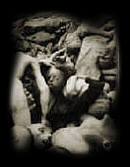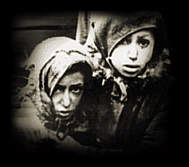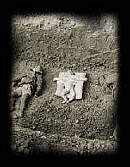





Built in March 1942 the deathcamp Sobibor operated from May 1942 until October 1943 for only one purpose: to kill as many Jews as quickly as possible. It was built near the small village of Sobibòr in the eastern sector of the Lublin district, close to a railroad line.
Sobibor's gas chambers killed an approximate total of 260,000 Jews. Most came from Poland and from the occupied areas of the Soviet Union and Western Europe.
Transports arrived by rail, and prisoners were taken immediately toward the gas chambers. But the victims did not know what awaited them until the gas was being pumped into the sealed chambers. The first transport included 10,000 Jews from Germany and Austria, 6,000 from Theresienstadt, and thousands from Slovakia.
In the first two months - from early May to the end of June - 100.000 Jews were murdered in Sobibor. The Nazis found that the gas chambers, which had a capacity of fewer than 600 people, were a bottleneck in the murder process. Therefore, a halt in camp operations in the summer was used to construct three more gas chambers, thus doubling the pace of extermination.
Other than killing Jews by the systematic method, SS also invented new ways to murder. They pushed Jews with umbrellas off roofs to assemble parachuting. Some stabbed workers in their backs with a small knife when the workers bent over to pick up branches.
Others sewed up prisoners' trousers after throwing rats inside. Babies were thrown directly into garbage pits or were torn apart down the middle by their legs.
Kalmen Wewryk miraculously survived Sobibor and later recalled a certain transport from Holland:
"There were too many Jewish children to be
"processed" rapidly so they were in a long, steadily shrinking
circular line from morning to night. Such beautiful children, gorgeous little
blonde girls with pigtails, decently dressed. These poor unfortunates were
well-fed, with pretty, round little faces. Their parents must have loved them
so, must have lavished such care on them, and now ... Many of them carried small
suitcases or bags. It was pitiful, so sad!
The SS men were watching over them.
Some of the kids were crying. They probably understood. The soil was sandy, so
some children made circles in the sand and they played with pebbles and
branches. After all, they were only children. Some children's eyes were full of
fear - they were wide-eyed with fear. It was a day straight out of hell! And
every minute less and less of them, less and less. The line got shorter and
shorter. And the children became smoke in those accursed skies ..."

Nazi KZ Auschwitz Bergen-Belsen Belzec Treblinka
The smallest of the extermination camps
operated by Nazi Germany during World War II, Sobibor also was the scene of the
war's biggest prisoner escape. On October 14, 1943, about three hundred Jewish inmates
rose in revolt killing several SS
supervisors and Ukrainian guards. Several inmates were killed during the
rebellion or during the escape attempt. All who stayed behind were executed the
next day.
After the escape the Sobibor deathcamp was torn down. Only 47 who could escape managed to survive the end of the war and give evidence of the existence of Sobibor and the revolt.
The killing installations were destroyed and the area planted over
with trees ...
![]()
© 2010-12
Louis Bülow Privacy
All Rights Reserved.
